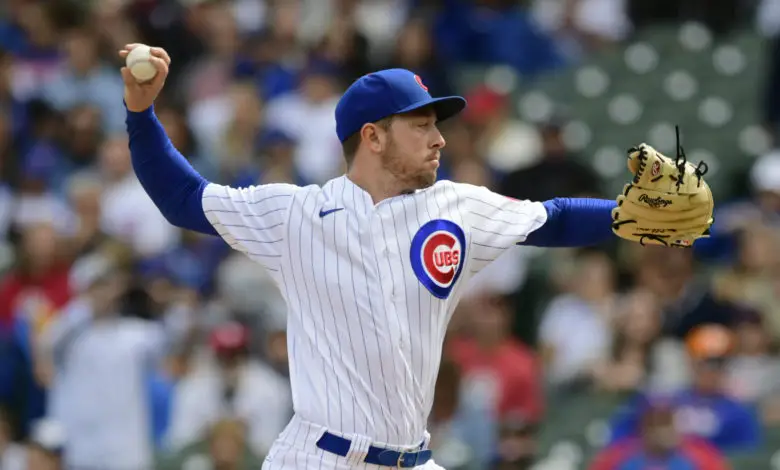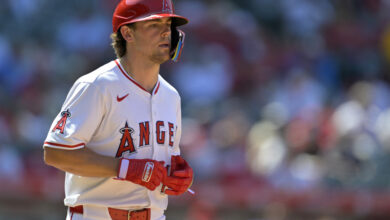
Yo, Adrian! Sampson Should Be Able to Leverage Revamped Repertoire to Repeat Success in 2023
One of the most pleasant surprises from an otherwise forgettable 2022 Cubs season was the emergence of Adrian Sampson as a viable option in the starting rotation. Nothing in Sampson’s past suggested that breakout, as he had briefly pitched for the Rangers and Mariners with less-than-stellar results over 153 innings as a swingman. He then pitched for the Lotte Giants of the Korea Baseball Organization in 2020, posting an unimpressive 5.40 ERA.
The Cubs decided to offer the journeyman hurler a minor league contract before the 2021 season and he spent most of the year at Triple-A Iowa. He was very effective in 35.1 innings at the major league level, pitching to a 2.80 ERA and an ERA+ of 152. Small sample size luck was definitely a factor, however, indicated by an expected ERA of 4.95 and an incredibly fortunate .232 batting average on balls in play.
With those suspicious underlying numbers in hand, Chicago brought Sampson back last season but once again started him in Iowa. By June, a bevy of injuries to the starting pitching staff thrust the then 30-year-old into the rotation, where his numbers were remarkably solid for the second consecutive season.
In a much bigger sample size of 104.1 innings of 21 appearances, all but two of which were starts, Sampson posted a career-best 3.11 ERA with a 3.79 FIP and .288 BABIP. Those are all pretty strong indicators that luck wasn’t a huge factor and they’re the kind of numbers any team would gladly take for a bottom-of-the-rotation pitcher. Now the question is whether he sustain it for an entire season in 2023.
There are still a couple of red flags that indicate regression is at least possible, if not likely. Sampson’s ERA+ was down to 132, down from his ’21 performance but still above league average. His 17.1% strikeout rate was six points below the league average his swinging-strike rate of 9.3% was roughly two points below the rest of the league as a whole. What’s more, his 0.86 HR/9 mark was less than half of his previous career mark.
So most of the stats indicate Sampson’s success was not a product of good fortune, yet some others warned that the bubble could burst. Perhaps there’s something we can’t see in the metrics that would allow us to better determine the source of his turnaround.
Rather than simply getting different results with the same approach, Sampson worked with Triple-A pitching coach Ron Villone and development coach Thomas Boucher to tweak his grips and develop new pitches. He described it himself to The Athletic’s Sahadev Sharma in August of 2022 ($):
“(We) basically remade my whole arsenal,” Sampson explained. “I switched grips on the fastballs and slider, added a new changeup. I kind of wiped clean all my pitches and made them all better. It’s been a whole change. But I’ve always been able to throw the ball where I want to.
“So you don’t want to go to someone and say, ‘Hey, change this grip,’ because it might screw your command up. But I was able to tinker with grips and could still throw the ball where I wanted to with better movement and pitch profile.”
Sampson upped the usage of his slider by 5% in 2022 compared to 2021 and backed way off on his changeup, throwing it 11% less than before. The most important change to his pitch mix, however, may have been the adjustments to his sinker. Publicly available data varies greatly when it comes to when he incorporated the pitch and how much he threw it, but FanGraphs has the sinker as his most frequently used offering in 2022 (36.5%).
The results generated by this new arsenal jump off the stat sheet, as Sampson’s hard contact allowed (25.8%) fell over 6 points from 2021 and more than 22 points from his 2019 results. As you might expect from the drop in homers, he also dropped his barrel rate allowed to 6.7% this past season. That’s 5 points better than in ’21 and roughly 50% better than his career mark through that campaign.
Perhaps the most impressive — or suspicious, if you prefer to avoid optimism — measure of Sampson’s new approach is that only 7.7% of his fly balls turned into home runs in 2022. That’s almost two-and-a-half times lower than he’d surrendered over his previous 188.1 innings (18.7%), and it came over a broad enough sample size to offer sufficient evidence to believe it was for real.
What it all comes down to is that we’re looking at a pitcher who avoided hard contact and walks with a reconfigured repertoire that includes positive pitch value on the four-seam, sinker, and change. With the Cubs’ improved infield defense able to convert softer contact into outs even more efficiently than last season, Sampson becomes even more valuable.
He should at least get a chance to stick in the rotation, where he might be able to reverse his rocky past to help the Cubs author their own Rocky moment.

